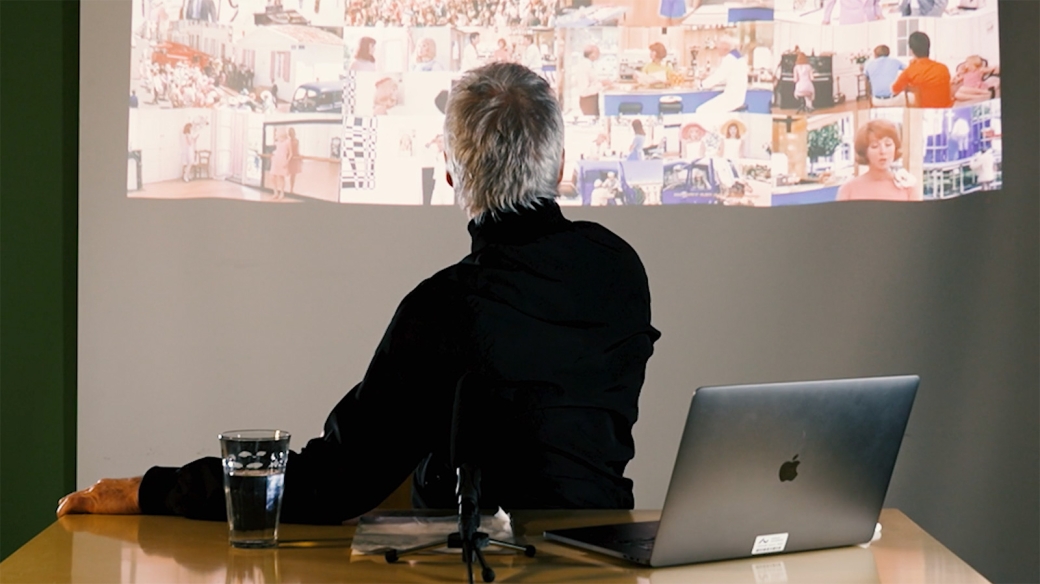
Still aus Nebular Epistemics (2023), Alan O’Leary
Nebular Epistemics
Nebular Epistemics: A Glossary (Scholarship Like a Spider or Spit)
Although I discuss one of the more abstract forms of videographic criticism in this piece, so-called ‹deformative› criticism, this video essay is itself closer to the disparaged mode of the illustrated lecture. «Nebular Epistemics» features a costumed persona seated at a desk and flanked by a screen with projected slides and clips. (The allusion, signalled in the music, is to the format of Spalding Gray’s filmed monologue, Swimming to Cambodia.)1 Other elements include extracts from videographic work by Jason Mittell and Jenny Oyallon-Koloski and from a film by Lars von Trier and Jørgen Leth.2 Their presence is self-explanatory. But the presence of segments from the recording of a car journey in which the maker inexpertly discusses ideas with his partner (dance artist and filmmaker Marie Hallager Andersen) might require some justification (the reason for the use of stills in these segments may be clarified in the credits to the video essay).
I forget where, but I once read a description of the paintings of R. B. Kitaj that praised the artist’s use of ‹first marks› – those clumsy but vivid first lines traced on a canvas to describe a figure or object. A different painter might have painted over or corrected such traces, but Kitaj often retained them, perhaps for their vitality, in work that might otherwise be highly finished and virtuosic. I wanted to adapt this idea of ‹first marks› for a video essay that has been highly worked, in order to acknowledge the process of thought, and in order to make visible some of the labour (the academic’s and his interlocutors’) often obscured in the making of a finished piece.
The hesitant and clumsy thinking recorded in these segments might make the spectator suspect the authority of the video essay’s male speaking persona; the tone of the piece (arch, perhaps) might make the spectator doubt his sincerity. The effect is intentional: part of the nebular ethos set out in the video essay is expressed in the possible unreliability of the speaker. In the quote used at the beginning of the video essay, Adorno suggests that the essay is a form in which «the thinker does not actually think but rather makes himself into an arena for intellectual experience».3 In a sense, then, the video essay speaker’s reliability is neither here nor there: what matters is the experience enabled by the video essay itself. And so, although it deploys the most formally conservative of modes, the illustrated lecture, I conceive of «Nebular Epistemics» as scholarship in a modernist idiom: an arrangement of strands and fragments designed to be (re-)composed by the spectator.
- 1Swimming to Cambodia, Dir.: Jonathan Demme, USA 1987.
- 2Jason Mittell, Object Oriented Breaking Bad, Vimeo, 2019, https://vimeo.com/336691810; Jenny Oyallon-Koloski, Musical Deformations: Les Demoiselles de Rochefort Grid, Vimeo, 2017, https://vimeo.com/231327035; The Five Obstructions, Dirs.: Lars von Trier and Jørgen Leth, Denmark 2003.
- 3Theodor Adorno: The Essay as Form, in: Theodor Adorno: Notes to Literature, New York 1991, 13.
Bildquellen
Abb. Still aus Nebular Epistemics (2023), Alan O’Leary
Bevorzugte Zitationsweise
Die Open-Access-Veröffentlichung erfolgt unter der Creative Commons-Lizenz CC BY-SA 4.0 DE.